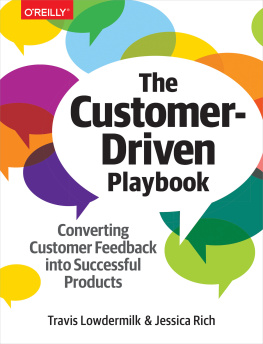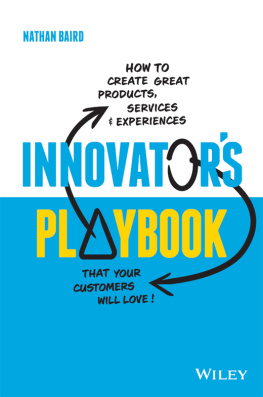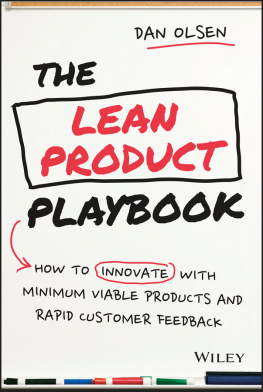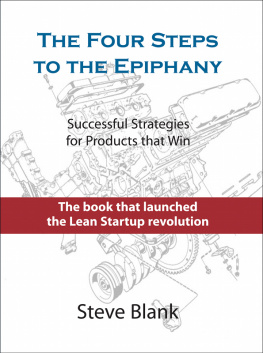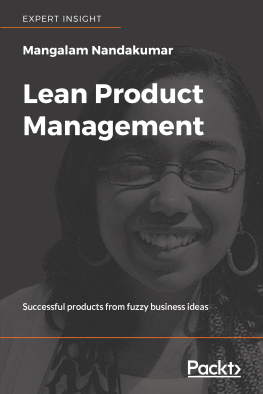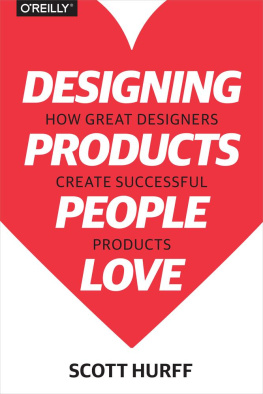This book belongs to Dr. Monty Hammontree, our team, and all our friends at Microsoft. Without them, this book would not have been possible.
Preface
Over the next 10 weeks, we want you to come up with product ideas that can attract new customers and triple our revenue.
Susan, a UX lead for PartyTime Apps, felt her mouth fall open and heard the team shift uncomfortably in their chairs.
Susan and her team worked on an immensely popular mobile party-planning app called PartyOrganizr.
The app was at the top of the charts in all the mobile app stores, and the company had enjoyed several years of success. Yet leadership was looking for ways to capitalize on their success and generate new revenue.
They didnt have a lot of time, so Susan believed the team needed to be Lean. She was going to have the team talk to as many customers as they could, iterate quickly, andabove all elsefail fast. She scheduled daily calls with customers and the team quickly fell into a cadence of meeting with customers, asking a myriad of questions, and taking copious notes.
The team had a lot of ideas about how they could generate new revenue, and they found that talking with customers was a great way to get direct feedback. Jerry, an engineer on the team, even started building a prototype for one of his ideas and began showing it to customers. It appeared that the team was on their way.
Then progress came to a complete halt. The team began arguing over what they were hearing from customers. Mary, a product manager, believed they werent asking the right questions or talking to the right types of customers. Even though it would be costly to build, Jerry was convinced that customers liked his prototype. Richie, the teams software tester, became hyperfocused on fixing bugs that customers happened to mention on the calls. The team was divided and heading in separate directions.
After the 10 weeks was complete, the team was left with a half-baked prototype that leadership deemed a solution in search of a problem. Even worse, after all the time they had spent with customers, the team had more questions than answers.
Does this sound familiar?
All too often, we find ourselves in this reality. While many Lean approaches and customer development strategies produced over the past decade have been transformational in how we think about building products, many teams find it difficult to put those principles into meaningful action.
Thats why weve come up with The Customer-Driven Playbook. Its a complete end-to-end guide that will help you and your team move from understanding the customer to identifying their problems to conceptualizing new ideasand ultimately to creating fantastic products.
Bottom line: this book will help you and your team put Lean theory into action.
Every element of this book has been used in the real world. This methodology has been proven successful in an organization of over 8,000 people that spans multiple countries.
Who Can Use the Customer-Driven Playbook?
Most of our experience in building this methodology has been in the software industry, so our book has been written primarily with software and technology products in mind. However, you can use our framework successfully when creating any product or service.
More specifically, this book is for program, product, project, or service managers; UX, visual, and interaction designers; UX researchers; team leads; engineers; testers; managers; and directors.
In short, if you have a desire to make great products, this book is for you.
How Is This Different from Other User-Centered Methodologies?
The customer-driven approach puts customers at the center. You may be asking, How is that different from being user-centered?
We believe a user and a customer have some subtle, yet profound, differences.
We call the people who use our products customers because it acknowledges the fact that theyre choosing our products. When a customer chooses our product, its an incredible gift and its our responsibility to continually reward them for putting their trust in us.
Sam Walton was a multibillionaire who founded the colossal retail chains Walmart and Sams Club. He once said:
There is only one boss. The customer. And he can fire everybody in the company, from the chairman on down, simply by spending his money somewhere else.
Walton knew that his customers had the power to dictate whether his business succeeded or failed. When you transform your thinking from users (people who are currently using your product) to customers (people who are choosing your product), it shows respect and appreciation for the people who are deciding to use your products.
The Customer-Driven Playbook approach goes beyond usability and usefulness. It considers the customers motivation, goals, and desires, and starts to identify the problems and limitations that prevent them from achieving what they want to do.
Everyone is a customereither a current customer, a potential customer, or a churned customer (someone who has recently abandoned your product). At any point, the customer may choose to join you or leave you. So, you must continually ask yourself:
And ultimately:
How This Book Is Organized

